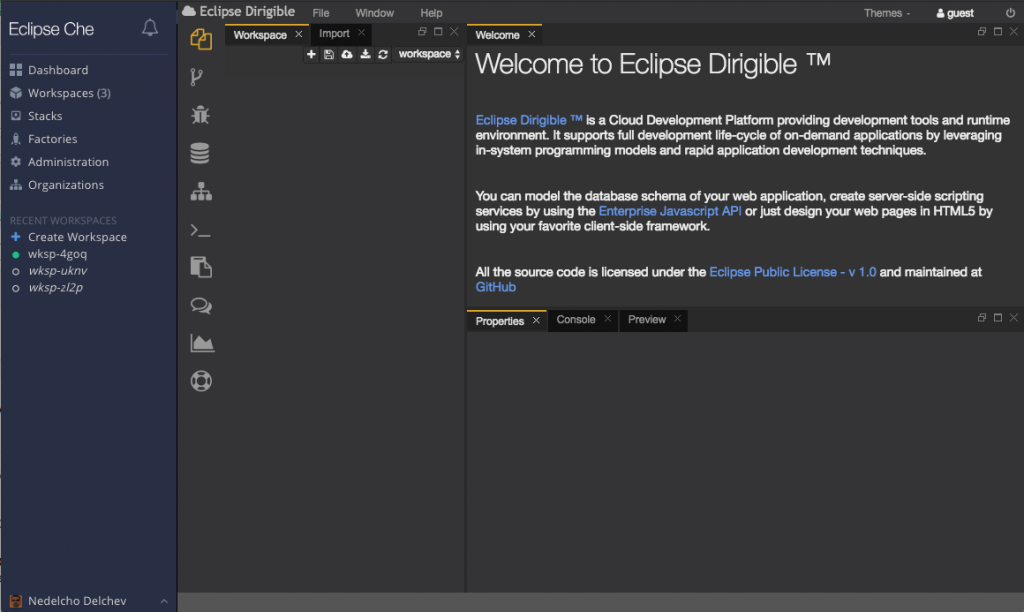A better plugin model, a new IDE, and Kubenative Workspaces — Eclipse Che Is on Fire !
With this article, I am starting a series of articles highlighting the new capabilities which will be introduced with Eclipse Che 7. This article provides an overview of the areas of focus for Eclipse Che 7 as well as its new IDE and ability to use different IDEs such as Jupyter.
Intro
What a year for Eclipse Che! Release after release, Eclipse Che gets better and better thanks to the engagement of the community and your feedback.
As an open source project, the core values of Eclipse Che are to:
- Accelerate project and developer onboarding: As a zero-install development environment that runs in your browser, Eclipse Che makes it easy for someone to join your team and contribute to a project.
- Remove inconsistencies between developer environments: No more: “but it works on my machine….” Your code works (or doesn’t) exactly the same way in everyone’s environment.
- Provide built-in security and enterprise readiness: As Eclipse Che becomes a viable replacement for VDI solutions, it must be secure and it must support enterprise requirements such as role-based access control (RBAC) and the ability to remove all source code from developer machines.
At the beginning of 2018 we shipped Eclipse Che version 6.0. That was a major milestone which added capabilities needed for developer teams and enterprises who wanted benefits from shared and rationalized developer environments. You can read more in the release note from Eclipse Che 6.0.
A few months ago, we announced during CheConf 18.1 the beginning of a new journey and a new chapter for Eclipse Che version 7. Seeing the interest from enterprises already using Eclipse Che and from the community that is building cloud-native applications, we organized the Che roadmap into 4 main areas:
- IDE.next: Updates to the editor to increase the joy of development.
- Plugins: Features to drive further growth in the Che ecosystem.
- Workspace.next: IDE tools running as microservices in containers to improve the fidelity between developer workspaces and production environments.
- Enterprises: Features to support large scale use of Che.
IDE.Next
We have integrated Eclipse Theia into Che to replace the GWT based IDE. Eclipse Theia has the foundation required to help us to enrich Eclipse Che.
Here is a small video showing the new IDE:
https://youtu.be/zDvmghmfPZQ
Only a few capabilities are shown in this video and there are a lot more to come. The most exciting ones are:
- Monaco based editor: blazing fast and responsive editor, codelens and much more
- Command Palette: Do everything without moving your hands from your keyboard
- Task Support: Tasks from VS Code are extended and support Che Commands
- Embedded Preview: Preview your application directly from the IDE, including Markdown preview.
- Customizable layout: Adapt the layout using drag and drop.
- And much more: Outline View, Search, Git
However, there is a substantial feature gap between Eclipse Theia and our current Che IDE. Most of this year has been spent adding needed features to Theia so that it can fully replace the current IDE. The Eclipse Che contributors have spent more than five years building web IDEs in the cloud. So when we decided to switch to Eclipse Theia, we naturally wanted to make good use of that experience to make the new IDE really substantial. And enterprise grade.
We’ve been working hard to bring:
- Debug Adapter Protocol
- Language Server Protocol
- Commands
- Preferences
- Keybindings
- Textmate Support
- Security
In the following months, that new IDE will become the default IDE for your workspaces.
Different IDEs for different use cases
There is one more thing. Che will still provide a default web IDE for workspaces, but we also did important work in order to decouple the IDE so that it is possible to plug a different IDE into Che workspaces. There are a lot of cases where the default IDE will not cover the use cases of your audience, or you might have stakeholders who are using a dedicated tool that covers their needs instead of using an IDE. In the traditional Eclipse IDE world, that was done with RCP applications.
With Eclipse Che 7, you’ll be able to plug any tool you want into a Che workspace:
- It can be based on Eclipse Theia (which is a framework to build a web IDE), such as the popular Sirius on the web: See the youtube video.
- Or it can be a completely different solutions, like Jupyter or Eclipse Dirigible
Here's example showing Jupyter in a Che Workspace:
https://youtu.be/VooNzKxRFgw
The team from Eclipse Dirigible is actually integrating their web IDE into Che workspaces too:
You can read more about Eclipse Dirigible in Che Workspaces in this article on dirigible.io.
That’s only the beginning!
That’s it for the first article introducing Eclipse Che 7.
My articles about Eclipse Che 7:
- Part 1—Eclipse Che 7 overview, and introducing the new IDE (this article)
- Part 2—introducing the plugin model
- Part 3—Kube-native developer workspaces
- Part 4—Functionality for Enterprise Development Teams and release timing
Get Involved!
Join the community:
- Support: You can ask questions, report bugs, and request features using GitHub issues.
- Public Chat: Join the public eclipse-che Mattermost channel to discuss with community and contributors.
- Weekly Meetings: Join us in our Che community meeting every second monday.
- Mailing list: che-dev@eclipse.org
Check out Red Hat CodeReady Workspaces for Red Hat OpenShift (Beta)
Built on the open-source Eclipse Che project, Red Hat CodeReady Workspaces provides developer workspaces, which include all the tools and the dependencies that are needed to code, build, test, run, and debug applications. The entire product runs in an OpenShift cluster hosted on-premises or in the cloud and eliminates the need to install anything on a local machine.
See the article CodeReady Workspaces for OpenShift (Beta) – It works on their machines too
Last updated: November 8, 2023
